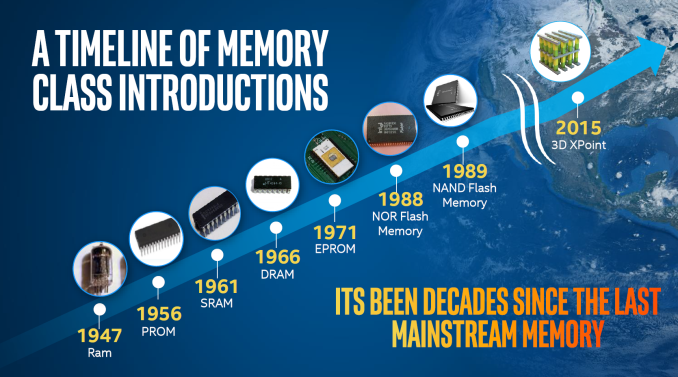Analyzing Intel-Micron 3D XPoint: The Next Generation Non-Volatile Memory
by Kristian Vättö, Ian Cutress & Ryan Smith on July 31, 2015 11:00 AM ESTFinal Thoughts
3D XPoint has a lot to chew on. There hasn't been an announcement this big in the memory industry since the invention of NAND in 1989 and while DRAM and NAND have improved and scaled a lot over the decades, 3D XPoint is really a new class of memory. It's fast, durable, scalable and non-volatile, whereas DRAM and NAND each only meet two of these criteria. It fills the niche between DRAM and NAND by taking the best characteristics of both technologies and creating a memory unlike anything we have seen before.
The significance of the announcement isn't just the new memory technology, but that it's actually in production with volume shipments scheduled for next year. Intel and Micron have succeeded in bringing a concept from a lab to an actual fab, which is by far the most difficult part in any new semiconductor technology. Something that works well in a lab may not be mass producible at all, but Intel and Micron made the necessary investments to develop new material compounds and surrounding technologies to turn 3D XPoint into a real product. It will be interesting to see how the other DRAM and NAND vendors respond because the memory industry is one where you don't want your rivals to have something you don't for an extended period of time.
However, it's clear that 3D XPoint isn't a true DRAM or NAND successor and Intel and Micron aren't trying to position it as such. DRAM will still have its market in high performance applications that require the latency and endurance that 3D XPoint can't offer. Our early cost analysis also suggests that 3D XPoint isn't as dense as planar NAND, let alone 3D NAND, but by having the ability to scale both vertically and horizontally 3D XPoint may have the potential to replace 3D NAND in the long run.
Looking further into the future, 3D XPoint isn't the only technology Intel and Micron are cooking. If the two stay on schedule, we should be hearing about their other new memory technology in roughly two years. As 3D XPoint seems to be more suitable as a 3D NAND replacement, the second new technology might be one that is capable of taking DRAM's place in the long run.
All in all, it's impossible to think of all the possible applications that 3D XPoint will have in the future because it's a technology that hasn't existed before. I don't think it's an overstatement to say that 3D XPoint has the potential to change modern computer architectures and the way we see computing, but that transition won't happen overnight and will likely require competing technologies from other vendors to fulfill the demand. What is clear, though, is that Intel and Micron are leading us to a new era of memory and computing next year.












80 Comments
View All Comments
dlop - Friday, July 31, 2015 - link
I'm still using only 5400 RPM HDDs. I'm waiting for DRAM-less SSD with 2-bit MLC memory, power loss protection and 5 year warranty.jamyryals - Friday, July 31, 2015 - link
Buy an enterprise SSD, they have those features.dlop - Saturday, August 1, 2015 - link
Enterprise SSDs are too expensive for low-end home desktop PC. Removing DRAM would make them cheaper because less capacitors should be needed. SSDs could be probably cheaper if they use solid capacitors which are used for motherboards. Bigger size of those capacitors isn't problem for desktop PC.Zan Lynx - Sunday, August 16, 2015 - link
You didn't specify cheap in your first comment. And you know that you can't have everything. If you want cheap then you give up something else. Like 5 year warranties and power loss protection.dlop - Monday, August 17, 2015 - link
Intel 535 is DRAM-less SSD with 5 year warranty without power loss protection. Solid motherboard capacitor cost about $1. DRAM-less PCIe or M.2 SSD with motherboard capacitors shouldn't be much more expensive than Intel 535.MrBowmore - Friday, July 31, 2015 - link
Intel 750?MrBowmore - Friday, July 31, 2015 - link
Not DRAM-free but with big capacitators that fills the disk with enough power to write down the cache. Most of the ram is for the indexing table anyway. Mabye you just hate DRAM?JKflipflop98 - Monday, August 3, 2015 - link
Awfully picky for someone willing to put up with such a crappy drive for so long.toooskies - Friday, July 31, 2015 - link
Not one mention of the mobile market, when they're an ideal place to replace DRAM + NAND. The fact that it's non-volatile will cut idle power usage, and you save PCB space by including it all in a single chip. Obviously database servers will be huge, but the place we're likely to see this stuff on the consumer market is in a cell phone.Freakie - Friday, July 31, 2015 - link
Bottom of the Products & Applications page talks about mobile devices. It'd be great for all of the low-end to mid-range smartphones but the high end ones that do benefit from fast RAM are likely to keep using RAM while the more mainstream phones could potentially switch to Xpoint.